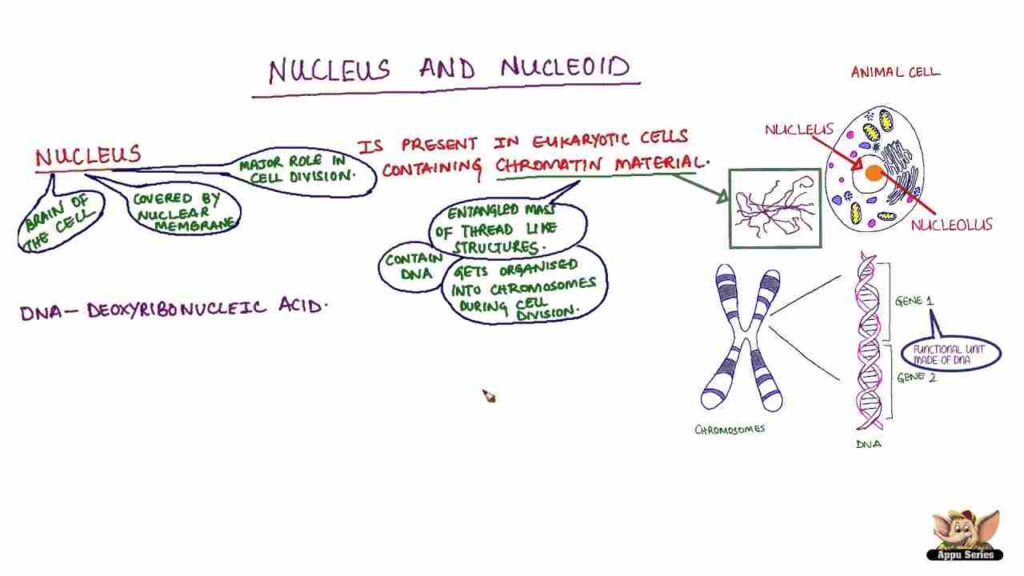
Explore 15 Key Difference between Nucleus and Nucleoid
Nucleus and nucleoid are two terms commonly used in biology to describe structures found in cells. While they both play crucial roles in genetic material organization, they differ in their characteristics and functions. Here are 15 key difference between nucleus and nucleoid explained in simple words for your upcoming exams, so read and make notes.
Difference between Nucleus and Nucleoid
Location: The nucleoid is an area within the cytoplasm of prokaryotic cells, whereas the nucleus is a membrane-bound organelle found in eukaryotic cells.
Nuclear envelope: The nuclear envelope is a double-layered membrane that surrounds the nucleus and separates it from the cytoplasm. The nucleoid, on the other hand, is not compartmentalised and does not have a membrane.
DNA is found in the nucleus as chromosomes, which are arranged and linear structures. On the other hand, the bacterial chromosome, a circular DNA molecule, is typically housed in the nucleoid.
Several proteins that are associated with the nucleus aid in DNA replication, transcription, and the control of gene expression. Both extensive protein association and specialised proteins for gene regulation are absent from the nucleoid.
The nucleus is compartmentalised, with a distinct interior called the nucleoplasm that includes a number of smaller compartments, including the nucleolus. There is no such compartmentalization in the nucleoid.
Size: In eukaryotic cells, the nucleus is considerably larger and takes up a sizable portion of the cell volume. In contrast, prokaryotic cells have a smaller nucleoid that takes up less room.
DNA packaging: A complex known as chromatin is formed in the nucleus when DNA is tightly wound around histone proteins. The DNA in the nucleoid is loosely packed, making it simpler to access the genetic material.
DNA replication occurs in the nucleus during the cell cycle to ensure accurate genetic information is passed on to daughter cells. The nucleoid replicates its DNA as well, but it does so more quickly and with less complexity than eukaryotes do.
DNA is converted into RNA during transcription in the nucleus of eukaryotes. Transcription occurs in the cytoplasm close to the nucleoid in prokaryotes.
Nuclear pores are present in the nuclear envelope of the nucleus and control how molecules move between the nucleus and cytoplasm. Nuclear pores are absent on the nucleoid because it has no membrane.
Eukaryotic cells, such as those found in plants, animals, fungi, and protists, have nuclei. Prokaryotic cells, which include bacteria and archaea, contain a nucleoid.
Origin in evolution: Endosymbiosis, in which an ancestor prokaryotic cell engulfed another cell to produce the eukaryotic cell, is thought to have produced the nucleus. An ancient structure that can be found in the earliest forms of life is the nucleoid.
Chromosomes, which contain genes, are discrete units of DNA that are organised by the nucleus. Such organised structures are absent from the nucleoid, and genes are frequently grouped together.
Regulation of gene expression: The nucleus controls gene expression through a variety of mechanisms, including transcription factors and epigenetic changes. The nucleoid has few regulatory mechanisms and mainly depends on RNA polymerase being present to express genes.
Complexity of the cell: Eukaryotes have more complex and specialised cells because they have a nucleus. Prokaryotes have simpler cellular structures and functions because they lack a nucleus.
In conclusion, the structure, organisation, genetic material, function, and cellular complexity of the nucleus and nucleoid are different. We can better appreciate the variety and complexity of life on Earth if we are aware of these differences.
Also Read: Explore 15 Key Difference between fraud and misrepresentation